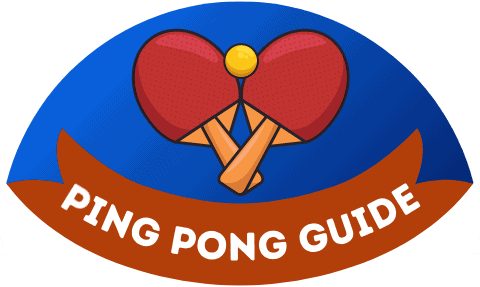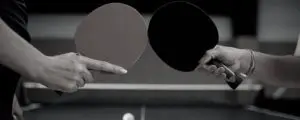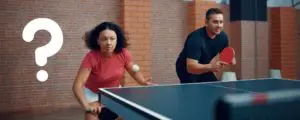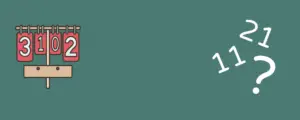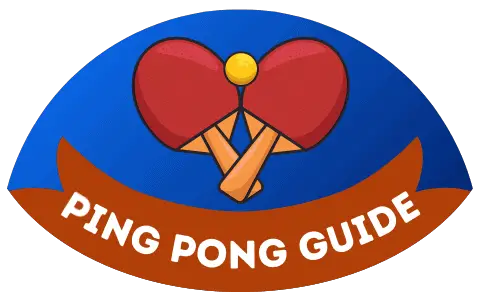As in other sports, there are situations in table tennis where a point is repeated. This is called a let. In this post, you will learn in which situations this is the case.
The most important in a nutshell:
“A let is a rally of which the result is not scored.” (Rule 2.5.3) – If a rally is a let, neither player gets a point and it is served again at the previous score. The most common case where this happens is the net serve.
Here is a short overview for you:
When do you repeat a point in table tennis?
Let on serve
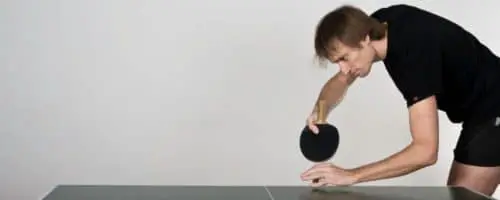
The most common situation that leads to a point repetition in table tennis is the serve. The reason for this is either that the ball touched the net during an otherwise correct serve (net serve) or the receiver was not ready.
Click here if you want to learn more about how to serve correctly in singles or doubles.
Net serve
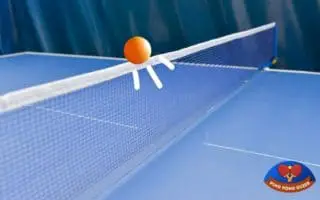
In the official rules this case is explained in point 2.9.1.1. It states:
A rally shall be a let…
“if in service the ball touches the net assembly, provided the service is otherwise correct or the ball is obstructed by the receiver or his or her partner;”
Thus, if Player A serves correctly and the ball goes first to his own and then to Player B’s side of the table, but touches the net in the process, the rally is repeated.
This is also the case if Player B returns, stops or catches the ball after it touches the net, above, and before it hits the table the second time.
If the ball goes out of bounce from the net, the receiver gets a point.
What is part of the net assembly?
In addition to the actual net, the two side posts, the net suspension and the clamps also count as part of the net assembly.
If an otherwise legal serve touches one of these objects, the serve is a let.
Repetition, by serving too early
If player A serves when player B is not yet ready to return the serve, the serve is repeated.
The corresponding rule 9.1.2 states the following:
A rally shall be a let,
if the service is delivered when the receiving player or pair is not ready, provided that neither the receiver nor his or her partner attempts to strike the ball;
Thus, for the serve to be considered a let, it is still important that player B or his partner (in the case of doubles) does not attempt to hit the ball.
If you make a racket movement towards the ball, even though you are not ready, the serve is not repeated. So after hitting the ball back, you can’t just say, “I wasn’t ready”.
If you are not ready for the return, it is best to just stand still.
Special rules for impaired players
If the receiver is sitting in a wheelchair, there are some more rules that apply when serving. An otherwise correct serve is a let if:
- 2.9.1.5.1 after touching the receiver’s court returns in the direction of the net;
- 2.9.1.5.2 comes to rest on the receiver’s court;
- 2.9.1.5.3 in singles leaves the receiver’s court after touching it by either of its Sidelines.
Is there a limit to how many times the serve can be repeated in table tennis?
No, the serve may be repeated as many times as necessary, as long as each time it is a let.
Let during the rally
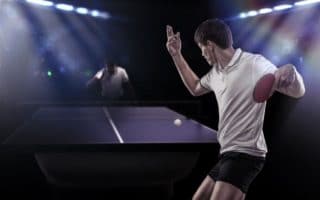
Even though a let occurs mostly when serving, there are also situations during the rally that leads to repetition.
This is less about actual game situations and much more about external factors.
Point replay due to interference
If a player is prevented from serving or returning the ball due to external interference or therefore cannot observe another rule, the point is repeated. (9.1.3)
It is important to note that the player is not responsible for the disturbance.
Typical situations that can lead to a let would be the disturbance by spectators or if you play outside, e.g. the wind can also be the reason for a replay.
Let by umpire interruption
If the umpire or his assistant interrupts the game during the serve or rally, the point is a let and will be retaken. (9.1.4)
There can be four reasons for an interruption of play:
- To correct an error in the order of serving, receiving or ends; (2.9.2.1 )
- To introduce the expedite system; (2.9.2.2)
- The expedite system is a tool to prevent too passive play. If a set lasts more than 10 minutes, it comes into effect.
- To warn or penalise a player or adviser; (2.9.2.3 )
- Because the conditions of play are disturbed in a way which could affect the outcome of the rally. (2.9.2.4 )
Let Overview
To wrap up this post, I’d like to list for you the most important reasons for a let.
A point is repeated…
- if, the ball touches the net on serve
- if the receiver was not yet ready for the serve
- if the returner is in a wheelchair and the serve is played too short or too wide.
- if external factors disturb the game
- if the referee interrupts the game because of errors, disturbances or time play
Still got questions?
I hope I was able to give you the answers you were looking for in this article. If you still have unanswered questions, you might find the right answer in our Q&A Section. Otherwise, you can ask them using the form below.
Enjoy the game 🙂
